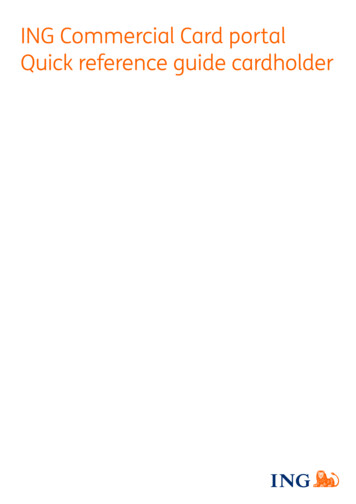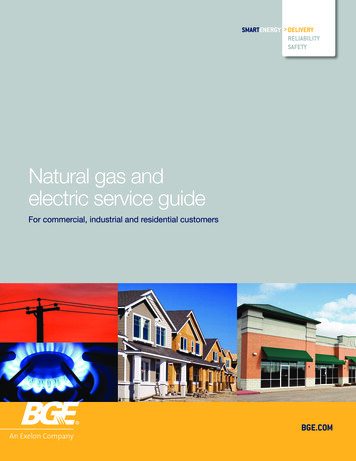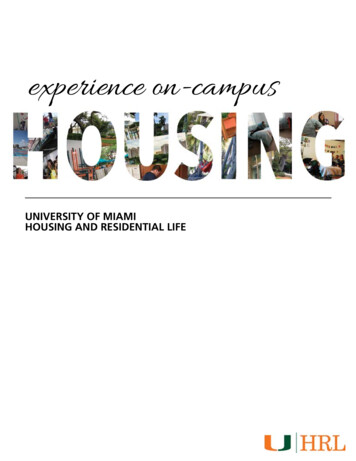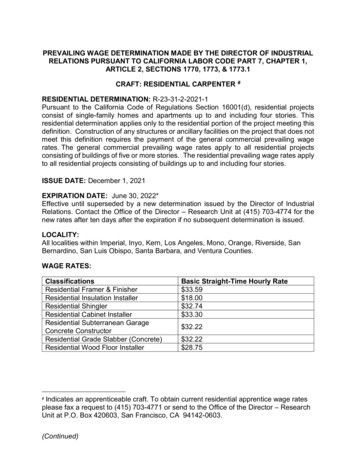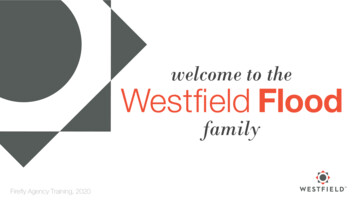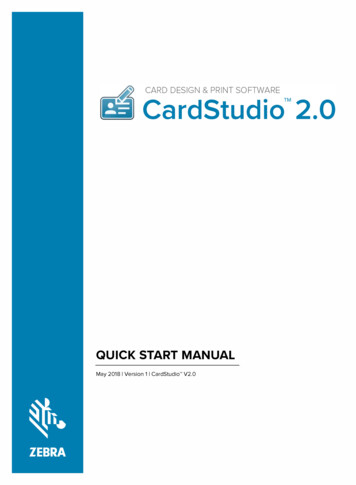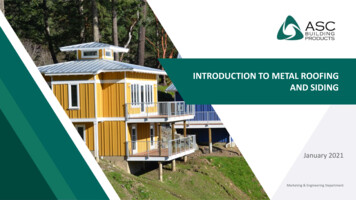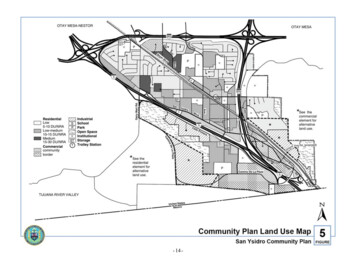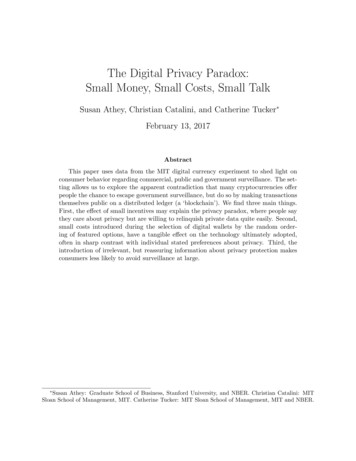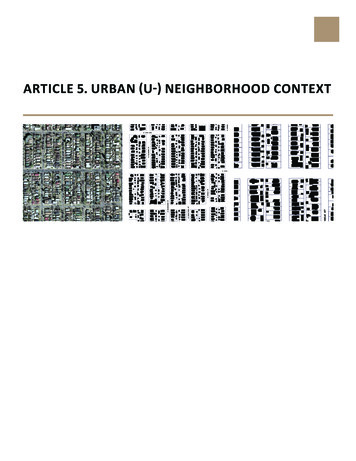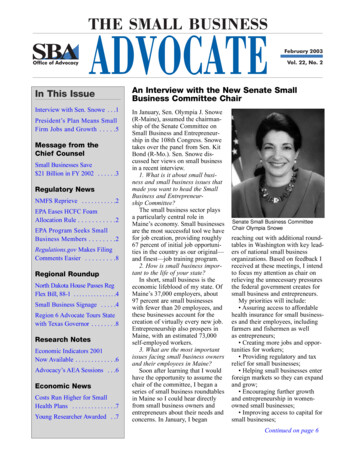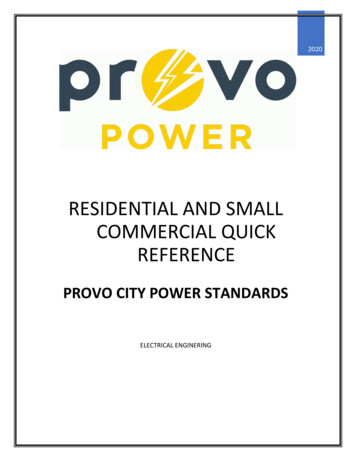
Transcription
2020RESIDENTIAL AND SMALLCOMMERCIAL QUICKREFERENCEPROVO CITY POWER STANDARDSELECTRICAL ENGINERING
TABLE OF CONTENTS1.2.ELECTRICAL SERVICE UPGRADE INFORMATION . 91.1PRE-INSPECTIONS REQUIRED ON ALL SERVICE UPGRADES: . 91.2PERMANENT POWER: . 9U.G. TEMPORARY POWER POST TYPE METER INSTALLATION . 112.1ADDITIONAL REQUIREMENTS: . 113.O.H. TEMPORARY POWER POST TYPE METER INSTALLATION . 134.TEMPORARY POWER METER PEDESTAL . 144.15.UNDERGROUND SERVICE INSTALLATION . 165.16.ADDITIONAL REQUIREMENTS: . 20OVERHEAD TO UNDERGROUND SERVICE INSTALLATION . 218.19.ADDITIONAL REQUIREMENTS: . 18MULTI-METER INSTALLATION WITH UNDERGROUND SERVICE 2-6 METERS. 207.18.ADDITIONAL REQUIREMENTS: . 16U.G. RESIDENTIAL RECESSED METER SERVICE . 186.17.ADDITIONAL REQUIREMENTS: . 14ADDITIONAL REQUIREMENTS: . 22TYPICAL RESIDENTIAL/SMALL COMMERCIAL SINGLE-PHASE OVERHEADSERVICE . 239.1ADDITIONAL REQUIREMENTS: . 2410. TYPICAL RESIDENTIAL UNDER EAVES SERVICE INSTALLATION . 2510.1 ADDITIONAL REQUIREMENTS: . 2611. CLEARANCES OF 600 VOLT SERVICE DROPS TO BUILDINGS, SIGNS, AND OTHERINSTALLATIONS TO WHICH ATTACHED (NESC RULE 234C3 AND 235C1) . 2711.1 ADDITIONAL REQUIREMENTS: . 2812. METER SOCKET WIRING DIAGRAM SINGLE PHASE, 3 WIRE, 120/240V OR120/208V, 3 WIRE NETWORK . 3012.1 ADDITIONAL REQUIREMENTS: . 3013. UNDERGROUND DISTRIBUTION SPECIFICATIONS (SINGLE PHASE) . 3113.1 ADDITIONAL REQUIREMENTS: . 3114. JOINT TRENCH TYPICAL DETAIL COMMERCIAL/RESIDENTIAL SUBDIVISION. 32Provo City Power PAGE 1 RESIDENTIAL AND SMALL COMMERCIAL QUICK REFERENCE July 2020
14.1 ADDITIONAL REQUIREMENTS: . 3214.2 REQUIRED TRENCH INSPECTION FOR PROJECTS: . 3314.3 REQUIRED TRENCH INSPECTION FOR SERVICES: . 3314.4PLACING ELBOWS INTO EXISTING POWER EQUIPMENT:.3314.5 FINAL PROJECT INSPECTION: . 3315. U.G. POWER INSTALLATION INTO EXISTING ENERGIZED EQUIPMENT . 3415.1 ADDITIONAL REQUIREMENTS: . 3516. TRANSFORMER AND PADMOUNTED EQUIPMENT ACCESS-CLEARANCES. 3616.1 ADDITIONAL REQUIREMENTS: . 3616.2 NOTE FOR NEW SERVICES: . 3617. SECONDARY PEDESTAL ACCESS CLEARANCES . 3717.1 ADDITIONAL REQUIREMENTS: . 3717.2 NOTE FOR NEW SERVICES: . 37TABLE OF FIGURESFigure 2.1 Underground Temporary Power . 11Figure 3.1 Overhead Temporary Power . 13Figure 4.1 Meter Pedestal . 14Figure 5.1 Underground Service Installation. 16Figure 6.1 Residential Working Clearances. 18Figure 7.1 Multi-meter Installation . 20Figure 8.1 OH to U.G. Service Installation . 21Figure 9.1 Pad Vault Specifications . 23Figure 10.1 Under Eve Installation . 25Figure 11.1 Clearances of 600 Volt Service Drops. . 27Figure 12.1 Meter Socket Wiring Diagram . 30Figure 13.1 Underground Specifications. 31Figure 14.1 Joint Trench Typical Detail . 32Figure 15.1.1 Connecting to a Sectionalizer . 34Figure 15.1.2 Connecting to a Pedestal . 34Provo City Power PAGE 2 RESIDENTIAL AND SMALL COMMERCIAL QUICK REFERENCE July 2020
Figure 15.1.3 Connecting to a Transformer . 35Figure 16.1 Access Clearances . 36Figure 17.1 Secondary Pedestal (Typ. 12”x20” lid approx.). 37Figure 18.1 Typical Grounding/Bonding . . .37Figure 19.1 Typical Grounding/Bonding for CT Cabinet . .38Provo City Power PAGE 3 RESIDENTIAL AND SMALL COMMERCIAL QUICK REFERENCE July 2020
DEFINITIONSANSI — American National Standards Institute.Arc flash hazard — A dangerous condition associated with the release of energy caused by an electric arc.Bushings — Plastic or nylon rings that attach to the ends of conduit to protect the electrical cable from sharpedges.Bypass — A method which allows for service continuity to the customer while the meter is removed for test orinspection.Common meter — A non-residential meter for general energy use in apartment complexes, multi-use, or othermulti-occupancy buildings. General energy use includes common area and exterior lighting, irrigation,laundry rooms, etc. Also called a house meter.CT — Current transformer (see Current transformer).Current transformer — A set of coils that reduce the primary current to the customer by a known ratio to anamount within the current capacity of the meter.Current transformer meter — A meter that requires current transformers because its current capacity is not aslarge as the customer’s current load.Customer — The individual requesting electrical service from Provo City Power.Direct connect meter — A meter energized to line voltage that carries all the load current. Also called a selfcontained meter. No current transformer or voltage interface is used.Direct connect socket — A meter socket connected to service wires, energized to line voltage and in series withthe customer’s load without external instrument transformers. A self-contained meter is used in a directconnect socket.Drip loop — The loop formed by the customer conductors that connects to the power company service drop. Theconductors are formed in a downward “loop” so water will not enter the customer’s service mast(weatherhead).Dwelling unit — A single unit, providing complete and independent living facilities for one or more persons,including permanent provisions for living, sleeping, cooking, and sanitation.Dwelling, single-family — A building that consists solely of one dwelling unit.Dwelling, two family — A building that consists solely of two dwelling units.Dwelling, multi-family — A building that contains three or more dwelling units.Electric vehicles — See EV below.ESRA — Electric Service Requirements Agreement, a formal, written agreement between the Company and thecustomer that describes the details of each installation. A Power Company representative fills out theESRA during the design process.EUSERC (Electric Utility Service Equipment Requirements Committee) — An association of electric utilities andmanufacturers that creates standard designs for the interface between the electric utility’s service and thecustomer’s facility.EV — Electric vehicle. An automotive type vehicle for highway use such as passenger cars, buses, trucks, vansand neighborhood vehicles primarily propelled by an electric motor powered by electrical energy fromrechargeable batteries or another source onboard the vehicle.EVSE — Electric vehicle supply equipment.Fault current — The available current under bolted short-circuit conditions.Provo City Power PAGE 4 RESIDENTIAL AND SMALL COMMERCIAL QUICK REFERENCE July 2020
Fiberglass conduit — Rigid conduit made of UV-resistant fiberglass, colored black with red stripesFree-standing metering assembly — A metering assembly not attached to a building.GMC — Galvanized metallic conduit.Grounding — Grounding in accordance with latest issue of NEC (Article 250, Grounding). Code enforcementagencies may require the ground connection to be visible when inspection is made. For safety reasons,the top of the ground rod should be flush or below ground level in permanent applications.House meter — A non-residential meter for general energy use in apartment complexes, multi-use, or othermulti-occupancy buildings. General energy use includes common area and exterior lighting, irrigation,laundry rooms, etc. Also called a common meter.HDPE conduit — A non-pressure-bearing conduit made from high density polyethylene plastic. ThePower Company limits the use of HDPE conduit for cable plowing and conduit boring.Hub — A conduit attachment in, or out of, a meter base can, into which electrical connections may be plugged.IMC — Intermediate metallic conduit.Living space — An area within a structure where the environment is controlled for cooking, cleaning, entertainingor sleeping. A garage is not considered living space.Mandrel — A non-flexible wooden cylinder, with pulling eyes at each end, pulled through conduit to confirm theconduit’s integrity by testing for obstructions and/or flattening.Manual link bypass — A bypass facility requiring the physical act of placing links across the line and load bypassstuds, for the purposes of removing the meter and preventing an outage while maintaining servicecontinuity.Manufactured home — A factory assembled structure or structures, site specific and transportable in one ormore sections, designed to be used as a dwelling with a permanent foundation.Meter — A device that measures and records the summation of electrical quantity over a period of time.Meter socket continuous rating — The rating, in amperes, that a meter socket will continuously carry for threehours or more under stated conditions without exceeding the allowable temperature rise. Typicalcontinuous duty ratings of sockets include 80, 160 and 320 Amps (ANSI C12.7).Meter socket maximum rating — The maximum rating of a meter socket in amperes; 125% of the continuousrating (EUSERC Section 300). Maximum ratings include 100, 200, and 400 Amps.Meter base — The mounting device consisting of jaws, connectors, and enclosure for socket-type meters.A mounting device may be either single or trough. The meter base is also referred to as a meter socket.Meter base ring — A metallic ring secured to the meter base that can be sealed by the power company.Meter pedestal — (Also see free-standing metering assembly.) A commercially built pedestal that contains ameter base and customer disconnect switches.Metered service conductor — A conductor carrying customer load that is recorded by the Power Company’sbilling meter.Mobile home — A factory-assembled structure or structures transportable in one or more sections, built on apermanent chassis and designed to be used as a dwelling without a permanent foundation.Modular home — A factory assembled structure or structures transportable in one or more sections, built on apermanent chassis and designed to be used as a dwelling with a permanent foundation.Mule tape — Flat low friction polyester tape with a minimum pulling strength of 1250lbs.NEC — The most recent publication of the National Electrical Code adopted by the state.NEMA — National Electrical Manufacturers’ Association.Provo City Power PAGE 5 RESIDENTIAL AND SMALL COMMERCIAL QUICK REFERENCE July 2020
NEMA 3R — A rating for water-tight enclosures, for any electrical equipment, indoors or outdoors.NESC — The most recent publication of the National Electrical Safety Code adopted by the state.Net metering — A debit and credit metering process in an account in which the customer owns and operates aqualified generating device that interconnects with the Power Company’s electrical facilities. Net meteringtariffs are available upon request.Network metering — Single-phase service obtained from two of the phase wires and the neutral of a 4-wiresystem.NFGC — The most recent publication of the National Fuel Gas Code.Non-residential service — Service to any customer who does not qualify for residential service.OSHA — Occupational Safety and Health Administration.Overhead service — See service drop.Phase converter — Any machine, circuit or device used to create additional phases for operating polyphasermotors or multi-phase devices from a single-phase source.Plumb — (In this book, this term refers to the meter base.) Having the sides and front of the meter base perfectlyvertical from both the front and side views.Point of delivery — See service point.Post — A pressure or thermally treated wooden structure that supports an underground service meter base.Primary service: Services with delivery voltages greater than 600 volts.Primary voltage — Over 600 volts.Power factor — The cosine of the angle, expressed as a percent, between voltage and current. Also, the ratio ofthe active power to the apparent power.PVC conduit — A gray-colored plastic pipe approved for use in electrical installations. Commonly referred to aspolyvinylchloride pipe.Residential service — Service furnished to customers for domestic purposes in single-family or duplexdwellings, or as defined by tariff.Relocation — A change in location of any of the following electrical system components: 1) the meterbase/socket, 2) the service drop, 3) the service lateral, or 4) the service entrance conductors.Rewire — Work performed on electrical wiring that requires any of the following: 1) re-installation of the meterbase/socket, 2) replacement of the service drop, 3) replacement of the service lateral, or 4) replacementof the service entrance conductors.RMC — Rigid metallic conduit.SAE — Society of Automotive Engineers.Safety socket — A device consisting of a manual link bypass facility and a circuit closing nut and bolt assemblywhich de-energize the meter socket while the meter is removed for test or inspection.Secondary distribution underground — A device 600 volts or less, going from transformer to secondarypedestal and between secondary pedestals.Secondary pedestal — Fiberglass enclosure for secondary connections.Secondary service — Customer delivery of secondary voltage, from either a transformer or a secondarypedestal to meter. See service lateral.Secondary voltage — 600 volts and under.Self-contained meter — A watt-hour meter connected directly to the supply voltage that is in series with thecustomer’s load without external instrument transformers.Provo City Power PAGE 6 RESIDENTIAL AND SMALL COMMERCIAL QUICK REFERENCE July 2020
Select backfill material — Material used to bed and cover direct-burial cables or conduits, consisting ofscreened native soil or sand free of sharp or foreign objects.Service — The conductors and equipment for delivering energy from the electric supply system to the wiringsystem of the premises served.Service conductors, underground system — See service lateral, underground.Service drop — The overhead service conductors from the utility’s pole, including the splices that connect to thecustomer’s service entrance conductors.Service drop attachment point — The location where the service drop conductors connect to the customer’sresidence, building or structure.Service entrance conductors (customer-owned) — The conductors between the terminals of the serviceequipment connecting to the service point. In an overhead system, the customer installs and owns thewires (service entrance conductors) from the splices at the service head (weatherhead). In anunderground system, the customer installs and owns the wires (service entrance conductors) from themeter.Service equipment — Customer-owned equipment, usually consisting of circuit breakers (or switches) andfuses, and their accessories, connected to the load end of service conductors to the customer’s structure,and intended to constitute the main control and cutoff of the supply.Service lateral, underground — The entire length of service conductors between the street main, including anyrisers at a pole or other structure, or from transformers, and the first point of connection to the serviceentrance conductors in a terminal box or meter or other enclosure, inside or outside the building wall.Where there is no terminal box, meter, or other enclosure, the point of connection is considered to be thepoint of entrance of the service conductors into the building.Service point — The point of connection between the facilities of the serving utility and the premises’ wiring.Service trench — A trench provided by the customer for a service lateral.Socket — A mounting device consisting of jaws, connectors, and enclosure for socket-type meters.Spoil — Native material removed from a hole or trench that is piled above grade, adjacent to the hole or trench.Sweep — A PVC, fiberglass or steel bend that changes the direction of the conduit.Switchboard — A large panel or assembly of panels which contains buses, current transformers, meters,switches, and protective devices.Tariff — A set of policies (or rules) and rates written by the Power Company, approved by the PublicService and Public Utility Commissions of each state served. All sections of the tariff are subject to updates at anytime. Individual state rules may affect the Power Company’s tariff. Tariff policy provides the working rulesby which the Power Company serves its customers.Test block facility (TBF) — An assembly used to bypass a self-contained meter socket.Test bypass facility (TBF) — See test block facility (above).Test switch — A device used by the Power Company to isolate the meter from current and voltage sources.Timber — A pressure or thermally treated wooden structure that supports an overhead service. Length dependsupon the type of installation.Underground cable — Electrical cable approved by a Nationally Recognized Testing Laboratory (NRTL) suitablefor direct burial in the ground or in conduit.Underground service — Electric service supplied to the customer from the power company utilizing undergroundconductors.Unmetered service conductor — A conductor carrying customer load that is not measured by theProvo City Power PAGE 7 RESIDENTIAL AND SMALL COMMERCIAL QUICK REFERENCE July 2020
Power Company’s billing meter.Unused facility — A facility that exists with no recorded customer or contractual obligation for a length of time(specified by the State).Provo City Power PAGE 8 RESIDENTIAL AND SMALL COMMERCIAL QUICK REFERENCE July 2020
1. ELECTRICAL SERVICE UPGRADE INFORMATION1.1Pre-inspections Required on all Service Upgrades:1.1.1All temporary electrical service installations shall meet Provo City Powerspecifications, National Electrical Code, and National Electrical Safety Code latestrevisions. Address to be posted at building site.1.1.2Provo City Power requires owner\builder to supply and install temporary power poleincluding meter base, disconnects and outlets. (See Figures 2.1, 3.1)1.1.3Temporary power connects are generally 300.00. Additional charges may benecessary depending on size and type of temporary power request.1.1.4Owner\builder shall have a Provo City building permit number prior to temporarypower connections.1.1.5Temporary power inspections will be scheduled on a first come basis, all temporarypower installations shall be inspected by Provo City Power prior to connection. Call(801)852-6999. Anything over 200 amps shall be inspected by Building Inspection.Call (801)852-6450 or (801)852-6452.1.2Permanent Power:1.2.1All permanent electrical service installations shall meet Provo City Power servicespecifications, National Electrical Code and National Electrical Safety Code latestrevisions, no customer owned equipment between meter base and meter. Addressto be posted at building site.1.2.2Contact Provo City Power at 251 West 800 North Provo, UT. for servicespecifications or call (801)852-6852.1.2.3Application for permanent electrical service must be completed by ownerbuilder\contractor prior to connection of permanent electrical service.1.2.4Main service disconnect is required outside at the meter location for all electricalservice installations. Provo City Power shall inspect trench and conduit installationprior to backfill. Call (801)852-6999 to schedule electrical service trench inspections.1.2.5Meter and service locations are to be determined by Provo City Power (seeattachment to job copy drawings). General rules for the service location are asfollows: the meter and main disconnect shall be setback from the front corner of thestructure a maximum of 12'. The meter and main disconnect shall be on the side ofthe structure closest to the distribution power source intended for that site.1.2.6All underground and overhead electrical services shall be inspected by Provo CityBuilding Inspection prior to connection by Provo City Power. Call (801)852-6450 or(801)852-6452 to schedule permanent power inspection.1.2.7All new developments will be serviced underground; owner/developer will beresponsible to provide and install all underground conduit, transformer pads/vaults,and secondary boxes, ground sleeves will be provided by Provo City Power andProvo City Power PAGE 9 RESIDENTIAL AND SMALL COMMERCIAL QUICK REFERENCE July 2020
installed by contractor. The underground electrical distribution layout shall becompleted or approved by Provo City Power engineering division.1.2.8All services over 200 amps require sch. 40 PVC conduit and conductor to besupplied, installed, terminated and maintained by owner / contractor per NEC, fromthe meter base to the power source supplied by Provo City. Services 200 amps andbelow Provo City will provide the conductor up to 75 feet max. The cost of theseconductors is included in the standard connection fees. For longer lengths consultwith Provo City Power for additional cost.1.2.9Provo City Power will not allow any new structure to be constructed under/over anyProvo City transmission/distribution, underground/overhead high voltage lines, orwithin any Right-of-Way or Public Utility Easement. All buildings and structures mustmeet Provo City Power overhead horizontal clearance requirements: 12’ for singlelevel structures, 20’ for multiple level structures from the nearest phase conductorthis includes balconies and edge of roof line. Other options: the power lines may beburied at owners’ expense. Please contact Provo City Power Engineering divisionwhen conflicts are identified, (801) 852-6852.Provo City Power PAGE 10 RESIDENTIAL AND SMALL COMMERCIAL QUICK REFERENCE July 2020
2. U.G. TEMPORARY POWER POST TYPE METERINSTALLATION249 NMETER SOCKET HEIGHT5' TO 6' FROM FINAL GRADEADDRESS TO BE POSTEDON TEMP POSTALL NON-CURRENT CARRYINGMETALLIC PARTS TO BE BONDED TONEUTRAL AND EFFECTIVELYGROUNDED -SEE FIGURES 18.1, 19.1FOR TYPICAL GROUNDING ANDBONDING DETAILS.GROUND WIRE CONNECTEDTO METER SOCKET NEUTRAL/GROUND TERMINAL#6 CU MIN. GROUND WIRESTAPLED TO POST2" GRS OR IMC CONDUIT MIN.24"MIN.WOODEN POST 4X4 MIN.PRESSURE TREATED. POSTTO BE PLUMB. RISER CONDUITTO BE SECURELY FASTENEDTO POST.TO BE LEFTEXPOSEDUNTIL AFTERINSPECTIONCOMPACTED BACK FILLTO STABILIZE PEDESTAL8' X 5/8" GROUND RODTO BE LEFT EXPOSEDUNTIL AFTER INSPECTIONSECONDARYPEDESTALSTUB 48" OF WIREINTO DE-ENERGIZEDSECONDARY PEDESTAL.IF PEDESTAL ISENERGIZED REFER TOFIGURE 15.1.2 FOR WIREINSTALLATIONAPPROPRIATELY SIZEDTRIPLEX WIRE24" MIN.Figure 2.1 Underground Temporary Power2.1Additional Requirements:2.1.1Weatherproof, 3 wire, 240V, breaker and outlet cabinets are required. Ground faultcircuit interrupters are required. (GFCI) on all outlets.2.1.2Pedestal and related equipment furnished by customer.2.1.3Installation by customer.2.1.4Pedestal must be placed within 10 feet and no closer than 2 feet to existingtransformer or secondary pull box. Do not obstruct access to power boxes2.1.5Wire and trench to be furnished by customer.Provo City Power PAGE 11 RESIDENTIAL AND SMALL COMMERCIAL QUICK REFERENCE July 2020
2.1.6Meter shall face street.2.1.7Meter pedestal to be inspected by Provo City Power. Call (801)852-69992.1.8Call (801)852-6999 for access to transformer enclosures or secondary pedestals.2.1.9Temporary power requirements larger than 200A will be approved by Provo CityBuilding Inspection department and installed by customer.Provo City Power PAGE 12 RESIDENTIAL AND SMALL COMMERCIAL QUICK REFERENCE July 2020
3. O.H. TEMPORARY POWER POST TYPE METERINSTALLATION18" MIN. OF TAIL.(NEUTRAL CONDUCTOR MUSTBE WHITE OR IDENTIFIED.)12"MAX.ALL NON-CURRENT CARRYING METALLICPARTS TO BE BONDED TO NEUTRAL ANDEFFECTIVELY GROUNDED -SEE FIGURES18.1, 19.1 FOR TYPICAL GROUNDING ANDBONDING DETAILS.6"SECONDARYSERVICECONDUCTOR BY: PROVOPOLE: 4"x4"x16' MIN.SUPPLIED & INSTALLEDBY: OWNER\CONTRACTOR249 NNOTE:SERVICE LENGTH TO BEMAXIMUM OF 80'TO NEAREST O.H.DISTRIBUTION POLE.ADDRESS TO BE POSTEDON TEMP POST12' MIN.2" GRS OR IMC CONDUIT MIN.WEATHERPROOF3 WIRE METER SOCKETMAXIMUM CAPACITY 200 AMP5' TO 6' TOFINAL GRADEOUTLET RECEPTACLES, 2 WIRE,120 VOLTS AND 3 WIRE, 240VOLTS. BREAKER AND OUTLETCABINETS ARE REQUIRED TO BEWEATHERPROOF. GROUND FAULTCURRENT INTERRUPTORS AREREQUIRED FOR ALL CIRCUITS3' MIN.TO BE LEFTEXPOSED UNTILAFTER INSPECTION2"x4" BRACES(FRONT BRACE HIDDENFOR CLARITY)8' X 5\8"GROUND RODPER NEC#6 CU MIN.STAKE AT EACH BRACECALL PROVO CITY POWER FORINSPECTION: 801-852-699918"Figure 3.1 Overhead Temporary PowerProvo City Power PAGE 13 RESIDENTIAL AND SMALL COMMERCIAL QUICK REFERENCE July 2020
4. TEMPORARY POWER METER PEDESTALALL NON-CURRENT CARRYINGMETALLIC PARTS TO BE BONDED TONEUTRAL AND EFFECTIVELYGROUNDED. SEE NOTE 4.1.10 BELOW.3 WIREMETERSOCKETADDRESS TO BE POSTEDON TEMP. PEDESTAL249 NOUTLETRECEPTACLESSTUB 48" OF WIREINTO DE-ENERGIZEDSECONDARY PEDESTAL.IF PEDESTAL IS40"ENERGIZED, REFER TOFIGURE 15.1.2 FOR WIREINSTALLATION24"MIN.PEDESTAL SHALL BEWEATHERPROOFTO BE LEFTEXPOSEDUNTIL AFTERINSPECTIONSECONDARYPEDESTAL72"BURY TO GRADELINE ON PEDESTAL32"APPROPRIATELY SIZED TRIPLEX WIRE18" MIN. DEPTHCOMPACTED BACK FILL#6 CU MIN.8' X 5/8" GROUND RODFigure 4.1 Meter Pedestal4.1Additional Requirements:4.1.1Weatherproof, 3 wire, 120/240V, breaker and outlet cabinets are required. GFCIprotection required on all outlets.4.1.2Pedestal and related equipment furnished by customer.4.1.3Installation by customer.4.1.4Pedestal must be placed within 10 feet and no closer than 2 feet to existingtransformer or secondary pedestals. Do not obstruct access to power boxes.4.1.5Wire and trench to be furnished by customer, with in 2' from power box.4.1.6Meter shall face street.Provo City Power PAGE 14 RESIDENTIAL AND SMALL COMMERCIAL QUICK REFERENCE July 2020
4.1.7Meter pedestal to be inspected by Provo City Power. Call (801)852-69994.1.8Call (801)852-6999 for access to transformer enclosures and secondary pedestals.4.1.9Temporary power requirements larger than 200 amps will be approved by Provo CityBuilding Inspection dept. and installed by customer.4.1.10Neutral and grounding conductors shall be bonded as per NEC 250.146.Provo City Power PAGE 15 RESIDENTIAL AND SMALL COMMERCIAL QUICK REFERENCE July 2020
5. UNDERGROUND SERVICE INSTALLATION100-200 AMP (1 OR 3 PHASE)ADDRESS TO BEPOSTED ATBUILDINGAMETER BASE &MAIN SERVICE DISCONNECTSECTION A-AMAIN SERVICE DISCONNECT IS REQUIRED OUTSIDE ATTHE METER LOCATION5' TO 6' FROMFINAL GRADE4 AWG CONDUCTORA3" MIN. GRS OR IMC.ANCHOR RISER CONDUIT TO FOUNDATION.ANCHOR TO BE ABOVE FINAL GRADE.CUSTOMER
Provo City Power PAGE 6 RESIDENTIAL AND SMALL COMMERCIAL QUICK REFERENCE July 2020 NEMA 3R — A rating for water-tight enclosures, for any electrical equipment, indoors or outdoors. NESC — The most recent publication of the National Electrical Safety Code adopted by the state. Net metering — A debit and credit metering process in an account in which the customer owns and operates a
